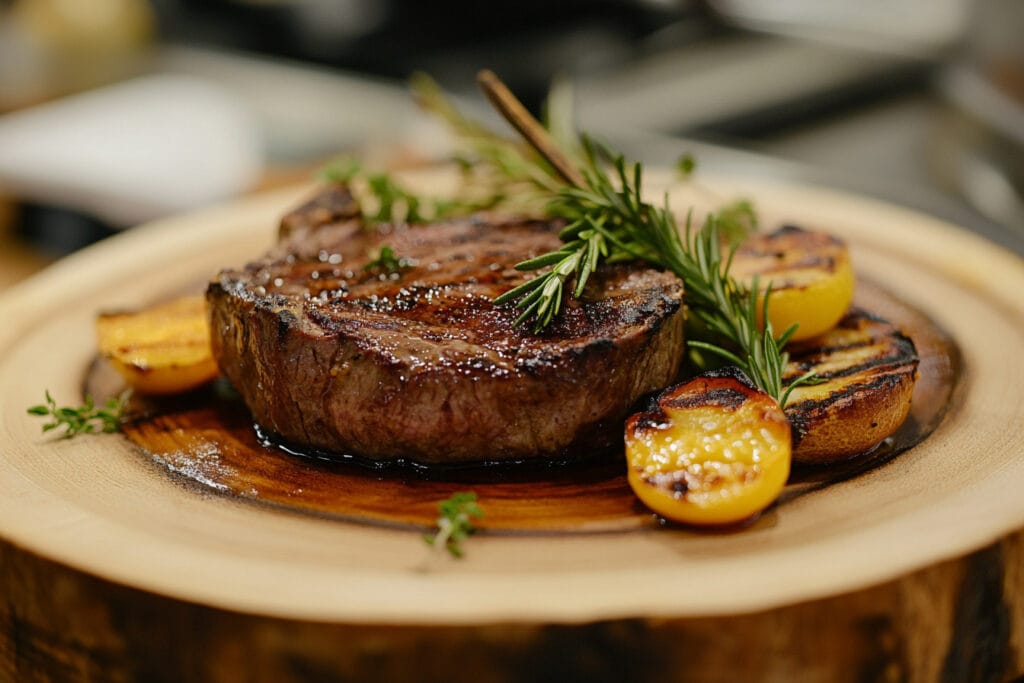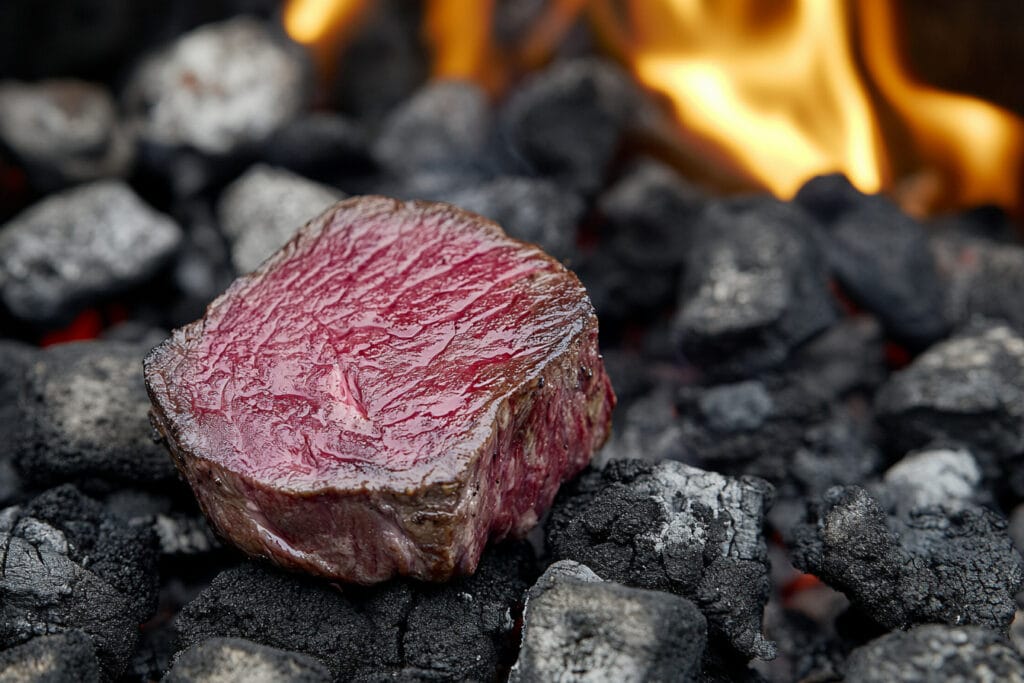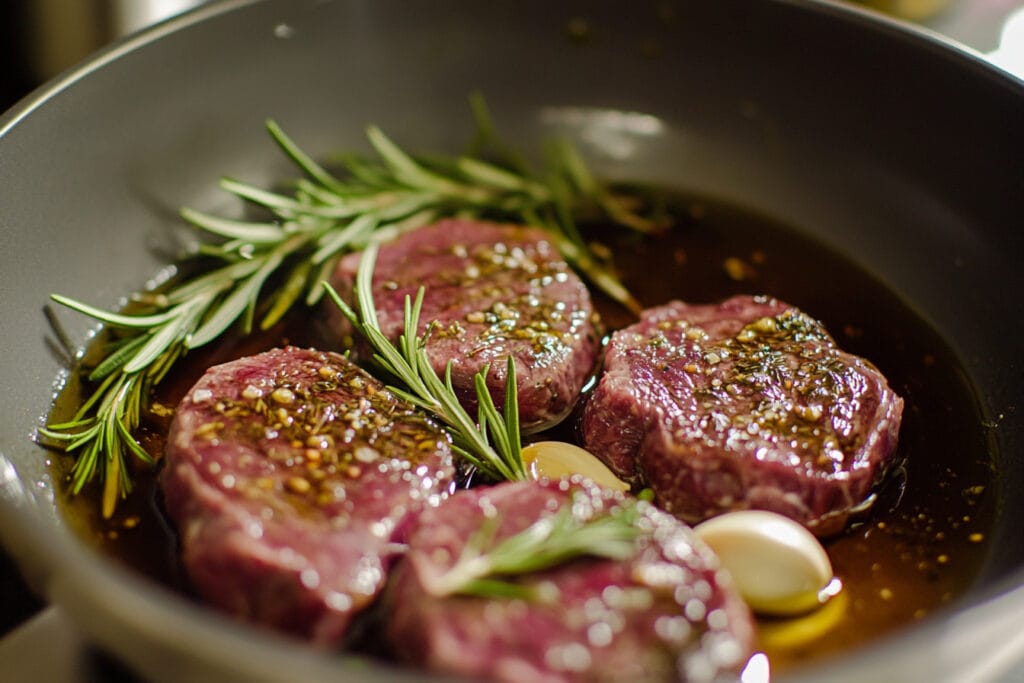
Venison, or deer meat, has long been prized for its rich flavor, lean composition, and versatility in the kitchen. Whether you’re a seasoned hunter or a curious foodie, cooking venison to perfection can seem challenging due to its unique characteristics. Unlike fattier meats like beef or pork, venison is incredibly lean, making it prone to drying out if overcooked.
So, what is the best temperature to cook venison? The answer depends on the cut, cooking method, and personal preference. Cooking venison at the right temperature is essential not only for safety but also for ensuring tenderness, juiciness, and flavor. This guide will explore the ideal temperatures for different venison cuts, the cooking methods that work best, and practical tips for consistently delicious results.
In the sections ahead, we’ll delve into why temperature is so important, discuss ideal cooking temperatures for various cuts, and offer practical tips to ensure your venison is always cooked to perfection.
Ideal Cooking Temperatures for Venison Cuts
Cooking venison requires an understanding of how each cut responds to heat. Whether you’re preparing a tender venison steak, a hearty roast, or ground venison for burgers, using the correct temperature is key to achieving the best results. Let’s explore the ideal cooking temperatures for different cuts of venison, so you know exactly how to handle this lean meat in the kitchen.
Venison Steaks and Chops
Medium-Rare: The Perfect Temperature
For venison steaks and chops, the best temperature to aim for is 130°F to 135°F (54°C to 57°C) for medium-rare doneness. Cooking to this temperature ensures the meat remains juicy and tender while retaining its rich, gamey flavor. Going beyond 135°F can cause the meat to dry out quickly, losing its delicate texture.
To achieve medium-rare:
- Sear the steaks or chops on high heat for 2-3 minutes per side.
- Finish them in the oven at 375°F (190°C) if needed, checking the internal temperature with a meat thermometer.
- Let the meat rest for at least 5 minutes before cutting to allow the juices to redistribute.
Rare or Medium: Alternative Preferences
If you prefer venison on the rarer side, aim for an internal temperature of 125°F to 130°F (52°C to 54°C). However, note that rare venison may have a slightly firmer texture and more gamey flavor. For those who like their steaks cooked a little more, medium doneness is achieved at 135°F to 140°F (57°C to 60°C), but anything beyond this risks overcooking.
Venison Roasts
Slow-Cooked Perfection
Roasts, such as venison loin or shoulder, benefit from slow and even cooking to tenderize the meat. For roasts, aim for an internal temperature of:
- 135°F to 140°F (57°C to 60°C) for medium-rare to medium doneness.
- If you prefer a slightly more well-done roast, go no higher than 145°F (63°C), as the meat can become dry and tough.
For a foolproof roast:
- Sear the roast on all sides in a hot skillet to lock in the juices.
- Transfer the roast to an oven preheated to 325°F (163°C).
- Use a meat thermometer to check the internal temperature and remove the roast once it reaches your desired doneness.
- Let it rest for 10-15 minutes before slicing.
Braised Venison for Tender Cuts
If you’re working with tougher cuts like the shank or shoulder, braising is a great option. Braising involves cooking the meat slowly at a low temperature in liquid, such as broth or wine. This method breaks down the connective tissue and collagen, resulting in melt-in-your-mouth tenderness. For braising, cook venison at 200°F to 250°F (93°C to 121°C) in the oven until the internal temperature reaches around 190°F (88°C) for maximum tenderness.
Food Safety is Key
Unlike whole cuts, ground venison must be cooked to a higher temperature for safety. Ground venison should always reach an internal temperature of at least 160°F (71°C). This temperature ensures that harmful bacteria, which can be introduced during the grinding process, are killed.
When cooking ground venison for burgers or meatloaf:
- Use a meat thermometer to confirm the internal temperature.
- Avoid pressing down on the burgers while cooking, as this can squeeze out the juices.
Internal Temperature Chart for Venison
Here’s a quick reference chart for venison cooking temperatures:
| Cut of Venison | Preferred Doneness | Temperature (°F) | Temperature (°C) |
|---|---|---|---|
| Steaks & Chops | Medium-Rare | 130°F to 135°F | 54°C to 57°C |
| Roasts (Loin, Shoulder) | Medium | 135°F to 140°F | 57°C to 60°C |
| Ground Venison | Well Done (Safe) | 160°F | 71°C |
| Braised Cuts | Fully Tenderized | 190°F | 88°C |
By following these temperature guidelines, you can ensure each cut of venison is cooked to perfection, balancing safety, flavor, and tenderness.
Cooking Methods and Their Impact on Temperature
The method you choose to cook venison plays a crucial role in achieving the right temperature for each cut. Whether you’re grilling steaks, roasting a loin, or slow-cooking a shoulder, the cooking technique significantly affects how heat penetrates the meat and influences its flavor, texture, and juiciness. Let’s explore the most popular cooking methods for venison and how to use them effectively.
Grilling Venison
Grilling is one of the most popular ways to prepare venison, especially steaks and chops. This method provides a smoky flavor and creates a caramelized crust on the outside of the meat while keeping the inside tender and juicy. To get the best results:
- Preheat the Grill: Heat the grill to medium-high, ensuring it’s hot enough to sear the meat quickly.
- Season the Meat: Use a light marinade or a simple rub with salt, pepper, garlic, and herbs. Avoid heavy marinades, as venison’s natural flavor is delicate and can be overwhelmed.
- Cook to the Ideal Temperature: Grill steaks or chops for 2-3 minutes per side, checking the internal temperature with a meat thermometer. Remove the meat once it reaches 130°F to 135°F (54°C to 57°C) for medium-rare.
- Rest the Meat: Allow the meat to rest for 5 minutes before serving to retain its juices.
Pro Tip:
Avoid over-flipping the meat on the grill. Frequent turning can cause it to cook unevenly and lose moisture.
Roasting Venison
Roasting is ideal for larger cuts of venison, such as the loin or haunch, where the goal is to cook the meat evenly without drying it out. A low-and-slow approach often works best for venison roasts.
- Sear the Meat First: Start by searing the roast on all sides in a hot skillet. This step locks in the juices and creates a flavorful crust.
- Cook in the Oven: Transfer the meat to a preheated oven at 325°F (163°C). For medium-rare doneness, roast until the internal temperature reaches 135°F to 140°F (57°C to 60°C).
- Use a Meat Thermometer: Insert the thermometer into the thickest part of the meat to ensure accuracy.
- Rest Before Slicing: Allow the roast to rest for 10-15 minutes after cooking to let the juices redistribute.
Pro Tip:
Roasting venison with vegetables, herbs, and a splash of red wine or broth enhances its flavor and keeps it moist.
Pan-Searing Venison
Pan-searing is a quick and effective way to cook smaller cuts of venison, such as steaks, medallions, or tenderloin. This method creates a rich, golden-brown crust while preserving the meat’s tenderness.
- Preheat the Pan: Heat a heavy skillet over medium-high heat. Add a small amount of oil or butter to prevent sticking.
- Sear the Meat: Place the venison in the pan and sear each side for about 2-3 minutes, depending on thickness. Avoid overcrowding the pan, as this can lower the temperature and prevent proper searing.
- Check the Temperature: Use a thermometer to confirm the internal temperature. Remove the meat at 130°F to 135°F (54°C to 57°C) for medium-rare.
- Rest the Meat: Let the venison rest for a few minutes before serving.
Pro Tip:
Deglaze the pan with a splash of wine or broth after cooking to make a quick and flavorful sauce for the meat.
Slow-Cooking Venison
Slow cooking is the go-to method for tougher cuts, like the shoulder or shank, that require tenderizing. The low, steady heat breaks down the connective tissue and collagen, resulting in succulent, pull-apart meat.
- Prepare the Meat: Brown the venison in a skillet to build flavor before placing it in the slow cooker.
- Add Liquid and Aromatics: Use broth, wine, or tomato-based sauces to create a flavorful cooking liquid. Add onions, garlic, and herbs for added depth.
- Cook Low and Slow: Set the slow cooker to low and cook for 6-8 hours, or until the meat reaches an internal temperature of 190°F (88°C). The extended cooking time ensures the meat is fully tenderized.
Pro Tip:
Keep the lid on during slow cooking to maintain moisture and heat consistency.

Sous Vide Cooking
Sous vide is a modern cooking technique that offers precise temperature control, making it ideal for venison. This method involves vacuum-sealing the meat in a bag and cooking it in a water bath at a controlled temperature.
- Set the Temperature: For venison steaks, set the sous vide machine to 130°F (54°C) for medium-rare.
- Vacuum-Seal the Meat: Season the venison and vacuum-seal it in a plastic bag.
- Cook in the Water Bath: Submerge the bag in the water bath and cook for 1-2 hours, depending on the thickness of the cut.
- Sear Before Serving: After sous vide, quickly sear the meat in a hot skillet for 30 seconds per side to develop a crust.
Pro Tip:
Sous vide is especially effective for maintaining venison’s delicate texture and flavor, as it minimizes the risk of overcooking.
By selecting the right cooking method for the specific venison cut, you can achieve optimal results every time. Each method has its strengths, but the key to success lies in controlling the temperature and allowing the meat to rest properly after cooking.
Common Mistakes to Avoid and Tips for Cooking Venison Perfectly
Cooking venison is an art that requires precision, patience, and an understanding of its unique characteristics. However, even seasoned cooks can make mistakes that lead to tough, dry, or flavorless meat. In this section, we’ll highlight the most common pitfalls and how to avoid them for consistently delicious results.
Overcooking Venison
Why It Happens
The most frequent mistake when cooking venison is overcooking. As venison is much leaner than beef or pork, it lacks the fat needed to keep it moist at higher temperatures. Once overcooked, venison becomes tough, dry, and loses its natural flavors.
How to Avoid It
- Use a meat thermometer to monitor the internal temperature closely.
- Cook steaks and chops to medium-rare (130°F to 135°F) and avoid temperatures above 140°F unless absolutely necessary.
- Remember that carryover cooking can raise the temperature slightly after removing the meat from the heat, so aim for 5°F below your target temperature.
Undercooking Certain Cuts
Why It Happens
While medium-rare is ideal for steaks and roasts, undercooking certain cuts—like ground venison or braised shanks—can result in chewy, unappetizing textures or even food safety concerns.
How to Avoid It
- Ground venison must be cooked to an internal temperature of at least 160°F to kill any potential bacteria.
- Tough cuts should be slow-cooked to at least 190°F to fully break down connective tissues, resulting in tender, flavorful meat.
Skipping Resting Time
Why It Happens
Many cooks are eager to dig into their venison as soon as it’s finished cooking. However, skipping the resting period causes the juices to escape when slicing, leaving the meat dry.
How to Avoid It
- Always rest venison for 5-10 minutes for steaks and up to 15 minutes for larger roasts.
- Cover the meat loosely with aluminum foil to keep it warm during resting.
Not Using Marinades or Fat
Why It Happens
Venison’s lean nature can sometimes result in a lack of moisture and richness, especially for less tender cuts. Many cooks overlook the importance of marinades or fail to add fat to enhance flavor and juiciness.
How to Avoid It
- Marinate venison for several hours (or overnight) using ingredients like olive oil, red wine, vinegar, or citrus to add moisture and tenderize the meat.
- For extra richness, wrap steaks or roasts in bacon, or cook them with a bit of butter or oil.
Cooking Directly from Frozen
Why It Happens
In the rush to prepare a meal, some cooks try to cook frozen venison without properly thawing it. This leads to uneven cooking and poor texture.
How to Avoid It
- Thaw venison in the refrigerator overnight for even defrosting.
- For quicker results, use a sealed bag in cold water, changing the water every 30 minutes.
Tips for Preparing and Cooking Venison Perfectly
Now that we’ve covered what not to do, let’s focus on practical tips to elevate your venison dishes to perfection.
Pre-Cooking Preparations
Trim the Silver Skin
Venison often has a layer of silver skin—a tough, connective tissue that doesn’t break down during cooking. Removing it ensures the meat is tender and avoids any unwanted chewiness.
Use a Marinade
Marinating venison enhances its flavor and tenderness. Popular marinade ingredients include:
- Olive oil or another fat for moisture.
- Acidic elements like vinegar, wine, or citrus juice to tenderize.
- Herbs, garlic, and spices for added flavor.
Seasoning Tips
Let the Meat Shine
Venison has a distinct, natural flavor that doesn’t need to be overpowered. Use simple seasonings like salt, pepper, garlic, and rosemary to complement the meat.
Avoid Heavy Sauces
Venison pairs well with light sauces made from wine, berries, or pan drippings. Avoid overly creamy or sugary sauces, which can mask its natural taste.
Resting After Cooking
Why It Matters
Resting venison is essential for retaining its juices. Cutting into the meat immediately after cooking allows the moisture to escape, leaving the meat dry.
How to Do It
- Place the meat on a plate or cutting board.
- Loosely cover it with foil and let it rest for 5-15 minutes, depending on the cut.
Adding Moisture and Richness
Incorporate Fats
Adding fats like butter, bacon, or olive oil can enhance venison’s flavor and prevent it from drying out. For roasts, basting with melted butter during cooking can work wonders.
Serve with Moist Accompaniments
Pair venison with side dishes that add moisture, like mashed potatoes, roasted vegetables, or a light gravy made from pan drippings.
Experiment with Cooking Techniques
Don’t be afraid to try different methods, such as grilling, pan-searing, or sous vide, depending on the cut. Each technique brings out unique qualities in the meat, helping you discover your favorite way to enjoy venison.
By avoiding common mistakes and following these preparation and cooking tips, you can consistently achieve perfectly cooked venison that is juicy, flavorful, and tender. Whether you’re cooking steaks, roasts, or ground meat, a little attention to detail goes a long way.

FAQs
What is the Ideal Temperature for Venison Steaks?
The ideal temperature for venison steaks is 130°F to 135°F (54°C to 57°C) for medium-rare doneness. This range keeps the meat tender and juicy while avoiding overcooking, which is crucial for lean meats like venison. You can also learn more about maintaining moisture in venison by exploring slow roasting techniques for venison.
Can You Eat Venison Medium-Rare?
Yes, venison can be safely enjoyed medium-rare if it is a whole cut, such as steak or roast. Medium-rare venison highlights the meat’s natural flavors and avoids the toughness that can result from overcooking. For roasts, consider following this guide to preparing the perfect venison roast for optimal results.
Ground venison, however, must be cooked to at least 160°F (71°C) to ensure safety, as grinding can introduce bacteria throughout the meat.
How Do I Keep Venison From Drying Out During Cooking?
To prevent venison from drying out, follow these tips:
- Avoid Overcooking: As venison is lean, it can dry out quickly when overcooked. Use a meat thermometer to monitor the temperature closely.
- Use Marinades: Marinades with acidic ingredients like red wine or apple cider vinegar help tenderize the meat and add moisture. Check out this guide on marinating venison for inspiration.
- Incorporate Fats: Cook venison with butter, olive oil, or bacon to add richness and moisture.
Should Venison Rest After Cooking?
Yes, letting venison rest after cooking is essential. Rest the meat for 5–15 minutes, depending on the cut. This process allows the juices to redistribute, keeping the meat moist when sliced. Discover more about achieving a tender roast in this comprehensive venison preparation guide.
What is the Best Method for Cooking Venison Roasts?
The best method for venison roasts is slow roasting at a low temperature, such as 325°F (163°C). This approach ensures tenderness and minimizes the risk of drying out. Tougher cuts like shoulder or neck benefit from braising or slow cooking in liquid. Explore the detailed venison roast recipe guide for step-by-step instructions.
Is Venison Healthier Than Beef?
Yes, venison is a healthier alternative to beef. It is:
Sustainably Sourced: Venison often comes from free-range or wild animals, offering an environmentally friendly option. Learn more about sourcing high-quality venison in this helpful guide.
Leaner: Venison contains less fat than beef, making it a lower-calorie option.
Rich in Protein: High protein content makes venison a nutritious choice for those seeking to build or maintain muscle.
Conclusion
Venison is a delicious and healthy meat that requires careful handling and cooking to bring out its best qualities. Whether grilling steaks, roasting a loin, or slow-cooking a shoulder, the key to success lies in achieving the right internal temperature for each cut. By using accurate temperature monitoring tools, avoiding common mistakes, and following expert tips for preparation and seasoning, you can enjoy perfectly cooked venison every time.
Remember, practice makes perfect, and experimenting with different cooking methods will help you find the technique that works best for you. With this comprehensive guide, you’re now equipped to confidently cook venison that’s both tender and flavorful.
